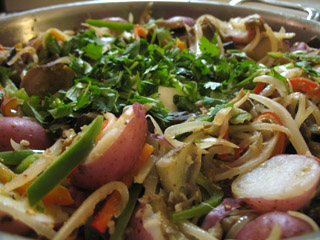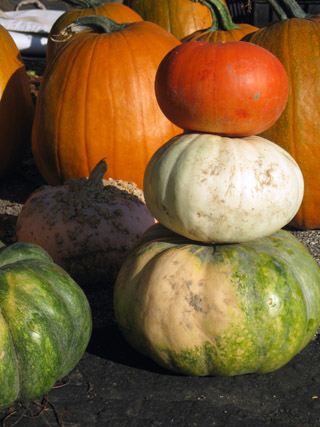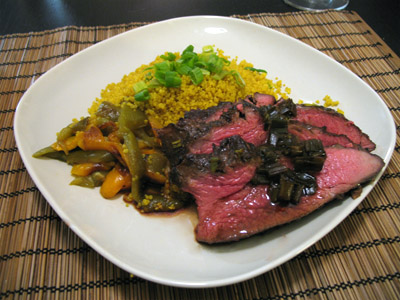No matter, a free Sunday can be devoted to baking a few loaves. The first loaf will be gone in a day and the second will be stale within another two. Friends will never eat as much bread as you'd like them to, so be prepared to consume vast quantities of carbohydrates, best toasted and enjoyed with some honey, before the second loaf goes completely stale.
I typically begin the night before "bake day" with some sort of starter. Throwing some yeast into a lightly salted wet dough develops some flavor and can reduce the amount of yeast one needs since it cultures overnight. The dough I generally use remains very wet, which it not such a problem if one is using a stand mixer. If you are working the dough by hand the kneading process can be a little sticky. There are some methods developed to work specifically with very wet doughs — "stretch and fold" being one of them. I'll try to accommodate a few different strategies in the end.
Parchment is a must here, according to a recent experience of Megan's — the choice other baking equipment is somewhat more flexible. Though I would love to cook both of these loaves simultaneously on my pizza stone this simply isn't geometrical conceivable in my current oven. Sheet pans should probably be shiny instead of black and heat-absorbing. The use of water for steam is not strictly necessary, though it feels rewardingly fancy.
Tasty Whole Wheat Loaves
 The Pre-Ferment
The Pre-Ferment- 1 Lb. 2 Oz. (~3.5 Cups) Arbitrary Mix of Flour (See Note)
- 1 Lb. 2 Oz. Filtered (or Good-Tasting) Water
- 1/2 Tbs. Salt
- 1/4 Tsp. Yeast
The Later Additions
- 14 Oz. (~2.66 Cups) Arbitrary Mix of Flour (See Note)
- 1/2 Cup. Cut Oats (optional)
- 4 Oz. Filtered (or Good-Tasting) Water
- 1/2 Tbs. Salt
- 1 Tsp. Yeast
- Parchment Paper
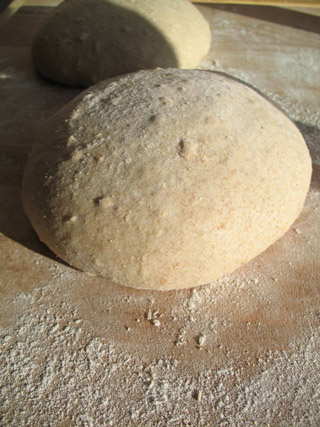 The Starter
The Starter- Combine all pre-ferment ingredients in a covered vessel and let sit overnight. This cultures the yeast a bit and allows the dough some time to develop flavor (though I feel that this is perhaps superstition.)
Mechanically Assisted Mixing
- Combine pre-ferment and additional ingredients in a stand mixer and run until the dough passes the window-pane test. It might be useful to stop the mixer after a few minutes and let the dough relax before continuing to mix to completion.
Manual Mixing
- Either try the stretch and fold method linked above, or knead by hand. Keep a spatula in one hand so you can lift the sticky dough off the counter with minimal effort. Keep either water or flour on your hands to keep the dough from sticking to you (different strategies work for different people.) Work the dough with the heels of your palms for a while until the texture begins to change — perhaps pause for a while before continuing toward the same final product as for the machine method.
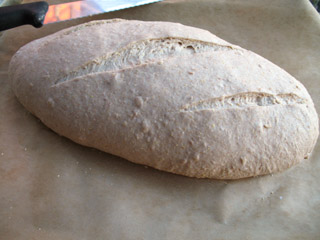 Moving On
Moving On- Transfer the dough to a lightly oiled bowl and dust with flour. Over the course of 2 1/2 hours take the dough out and fold it twice: on a liberally floured surface stretch the dough gently into a roughly rectangular shape, dust with flour, fold in thirds horizontally, fold again vertically, then return to bowl.
- Divide dough in two, and form both halves into desirably shaped loaves. A round loaf is a good start and is relatively easy to shape. The most important elements of shaping the dough is creating a taught upper surface. Place each loaf onto a sheet of parchment on a baking sheet. Cover and let rise for about 1 1/2 hours, at which point they will have gained substantial volume. Preheat oven to 450F well before this time is up.
- Slash loaves with a serrated knife as pictured above. Insert into oven and optionally throw some hot water into a pan at the bottom to create steam.
- Cook about 30-35 minutes until the internal temperature is around 200F, or alternatively until they look done and sound hollow when tapped on the bottom (this is also superstition...) Switch and rorate loaves halfway through through baking to ensure even cooking.
- Let rest for quite a while before slicing.
